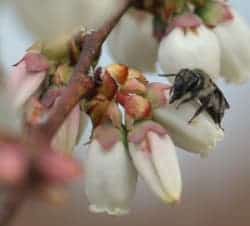We’ve written extensively about the impending global disaster triggered by the crippling of bee populations worldwide at the hand of Colony Collapse Disorder (CCD). Just recently, I wrote an article discussing the findings of a new paper that suggests the leading factors that cause CCD are most complex than previously thought – namely, a whole brew of pesticides and fungicides have been found to dramatically alter bee colonies. Now, North Carolina State University are proposing a set of guidelines for assessing the performance of pollinator species in order to determine which species are most important and should be prioritized for protection.

Photo of small native bee species Andrena bradleyi on a highbush blueberry flower. Click to enlarge. (Photo credit: Hannah Burrack.)
Whether we’re talking about flowers, vegetables or crops most of the pollinating is made by insect species. Clearly, insects play a key role in the biosphere, and the dramatic downfall of some of these pollinating species, namely bees, poses a dramatic threat to both plant life and the food chain. Which species are the best pollinators, though? This question may be important to answer to foster conservation efforts and better distribute resources to where they’re most needed or where these can be used most effectively.
“Widespread concerns over the fate of honey bees and other pollinators have led to increased efforts to understand which species are the most effective pollinators, since this has huge ramifications for the agriculture industry,” says Dr. Hannah Burrack, an associate professor of entomology at NC State and co-author of a paper on the new guidelines and related research. “However, various research efforts have taken a wide variety of approaches, making it difficult to compare results in a meaningful way.
“We’ve developed a set of metrics that we think offers a comprehensive overview of pollination efficiency, which would allow researchers to compare data from different crops and regions.”
The NC State study looked at four primary metrics when assessing pollinating capabilities of species.
- Number of seeds produced for one flower.
- Abundance, which measures the number of each type of bee observed in the area.
- Weather behavior: how active is the bee species during various weather conditions (cold, cloudy, windy etc.)
- Visitation rate: number of flowers visit function of the amount of time spent at each flower.
There’s no such thing as a perfect bee, apparently
“The perfect bee would produce a lot of seeds and visit a lot of flowers, even in poor weather – and there would be a lot of them,” Burrack says. “But as far as we know, the perfect bee doesn’t exist.”
I pilot study was made at a site made up of highbush blueberry crops in North Carolina. Small native bees had extremely high single-visit efficiency rates and were active during inclement weather, however it also found that th3se did not have high abundance nor appear to have high visitation rates.
“This highlights the importance of incorporating multiple metrics,” says Dr. David Tarpy, an associate professor of entomology at NC State and co-author of the paper. “Because researchers looking only at visitation rates or abundance may think the small native species are unimportant, when they actually appear to be important pollinators for blueberry growers.”
It’s possible that using these metrics, scientists can make a pollinating species effectiveness measure for their own local ecosystem, and thus have a broader picture. By measuring these key metrics, it may be possible also to assess how pesticides or lack of them influence these metrics.
The findings were reported in a paper published in the journal Environmental Entomology.









